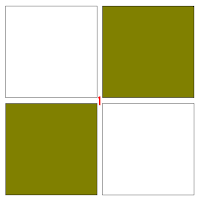 Specifically, I dreamed of a chess variant where the board consisted of sixteen numbered pieces like the little graphic to the right. They're laid out four by four to make a standard chess board and the game plays out pretty much like regular chess. The big difference is that at the end of each black move 2d20 are thrown. The numbers rolled indicate which two sub-boards to swap in the array, transporting all the pieces on each.
Specifically, I dreamed of a chess variant where the board consisted of sixteen numbered pieces like the little graphic to the right. They're laid out four by four to make a standard chess board and the game plays out pretty much like regular chess. The big difference is that at the end of each black move 2d20 are thrown. The numbers rolled indicate which two sub-boards to swap in the array, transporting all the pieces on each.No details in the dream indicated what to do when you rolled more than a 16 on either die, or how to resolve transporting a king into check. Obviously you could roll a d16 to eliminate the former problem, but maybe a roll of 17 or better indicates that you should skip swapping boards. Maybe if the king finds itself in check the player could be allowed to rotate the sub-board 90 or 180 degrees to move him out of check, otherwise skip the swap as if you rolled a 17+. Castling, the pawn's double move and en passant capture would probably all need to be scrapped in this variant. Would a pawn that magically appeared in the last rank suddenly get a promotion? That would certainly make things wild and wooly.
Being able to respond to white without the boards mutating seems like a tremendous advantage to black.
I don't recall every reading of a game exactly like this on the Chess Variants Pages, but it wouldn't surprise me to discover that it already exists.



.jpg)























































































































.JPG)





































.png)

.jpg)





















.gif)







1-16 + 17-19: Indicated board rotates 90, 180 or 270 degrees. 1-16 + 20: Switch colours of all pieces on indicated board.
ReplyDelete17-20 + 17-20: Switch the two indicated columns on the board.
20 + 20: Players switch sides?
I was thinking...
ReplyDeletePlacing a shaft in the middle of the tiles would make it easier to pick-up, and the knob on top of it could have the tile's number displayed.
2d10s would make more sense then d20s. That is, a roll of 1-8 indicates the tile-set to be moved, while a 9 or 0 indicates that a tile (that was rolled by the other die) to be rotated. The last two results are best marked by a yin-yang-like icon that indicated the direction of rotation (90 degrees clockwise or counter-clockwise). If both dice rolled a rotation, then both players take turns (starting with white) turning any one tile-set the way indicated by their chosen die. Rolling the same number has no effect. It maybe ruled that rolling the same or opposite rotation icons yields no effect. (keeping things simple makes it easier to consider all angles)
This would add a lot of randomness and uncertainty to a game that is pure strategy at it's core.
By the way, that link you put-up also features Dragon Chess - a 3D fantasy chess game by Gary Gygax.
Jeff, I own a Piecepack (kind of an open-source board game) and I think some of those pieces could be helpful to you with this idea. Just my $0.02. :)
ReplyDelete